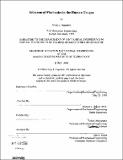| dc.contributor.advisor | Richard J. Gilbert and Rohan Abeyaratne. | en_US |
| dc.contributor.author | Napadow, Vitaly J., 1971- | en_US |
| dc.date.accessioned | 2005-08-19T18:48:04Z | |
| dc.date.available | 2005-08-19T18:48:04Z | |
| dc.date.copyright | 1998 | en_US |
| dc.date.issued | 1998 | en_US |
| dc.identifier.uri | http://hdl.handle.net/1721.1/9595 | |
| dc.description | Thesis (S.M.)--Massachusetts Institute of Technology, Dept. of Mechanical Engineering, 1998. | en_US |
| dc.description | Includes bibliographical references (p. 77-80). | en_US |
| dc.description.abstract | Contraction of the tongue musculature during physiological motions (anterior protrusion, sagittal bending, swallowing) is associated with characteristic patterns of tissue deformation. Coupling knowledge of this tissue deformation with the underlying myoarchitecture offers the ability to explore complex structure-function relationships in the organ. In order to quantify strain in the human tongue, a non-invasive MRI tagging technique was used in combination with a fast asymmetric gradient echo imaging pulse sequence (TurboFLASH). This MRI technique discretize tissue into non-linear deforming elements. Individual elements were defined by selectively supersaturating bands of magnetic spins in resting tongue tissue along the antero-posterior and superiorinferior directions of the mid-sagittal plane, resulting in a rectilinear square grid. Axial and shear strains relative to the rest condition were determined for each element and represented by two-dimensional surface strain maps. Tongue myoarchitecture was studied with diffusion-tensor MRI. A slice select pulsed gradient stimulated echo pulse sequence was applied to derive the spatial diffusion tensor field in the tongue. Tensor eigenvectors and measures of anisotropy were used to derive a virtual anatomical atlas of the bovine tongue. During forward protrusion, the anterior tongue underwent positive antero-posterior strain ( elongation) and symmetrical negative medial-lateral and superiorinferior strain ( contraction). During sagittal bending directed to the hard palate, the tongue exhibited positive asymmetrical antero-posterior strain that increased radially as a function of distance from the center of curvature, with commensurate negative strain in the medial-lateral direction. Similarly, the magnitude of anterior-posterior strain during left-directed tongue bending was proportional to distance from the curved inner surface. The oral stage of the swallow was subdivided into an early accommodative phase, a late accommodative phase and a propulsive phase. For bolus accommodation, strain findings were consistent with contraction of the anteriorly located intrinsic muscles and the posteriorly located genioglossus and hyoglossus muscles. For bolus propulsion, strain findings were consistent with posterior passive stretch in the midline due to contractions of the laterally inserted styloglossus muscle, as well as contraction of posteriorly located intrinsic muscles. In conclusion, regulation of tongue deformation was related to regional activation of intrinsic and/or extrinsic lingual musculature, which was appreciated with 3D diffusion tensor visualization. | en_US |
| dc.description.statementofresponsibility | by Vitaly J. Napadow. | en_US |
| dc.format.extent | 80 p. | en_US |
| dc.format.extent | 6734876 bytes | |
| dc.format.extent | 6734636 bytes | |
| dc.format.mimetype | application/pdf | |
| dc.format.mimetype | application/pdf | |
| dc.language.iso | eng | en_US |
| dc.publisher | Massachusetts Institute of Technology | en_US |
| dc.rights | M.I.T. theses are protected by copyright. They may be viewed from this source for any purpose, but reproduction or distribution in any format is prohibited without written permission. See provided URL for inquiries about permission. | en_US |
| dc.rights.uri | http://dspace.mit.edu/handle/1721.1/7582 | |
| dc.subject | Mechanical Engineering | en_US |
| dc.title | Intramural mechanics in the human tongue | en_US |
| dc.type | Thesis | en_US |
| dc.description.degree | S.M. | en_US |
| dc.contributor.department | Massachusetts Institute of Technology. Department of Mechanical Engineering | en_US |
| dc.identifier.oclc | 42192319 | en_US |
